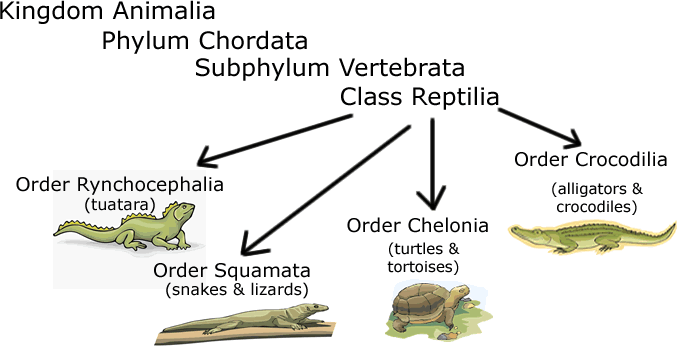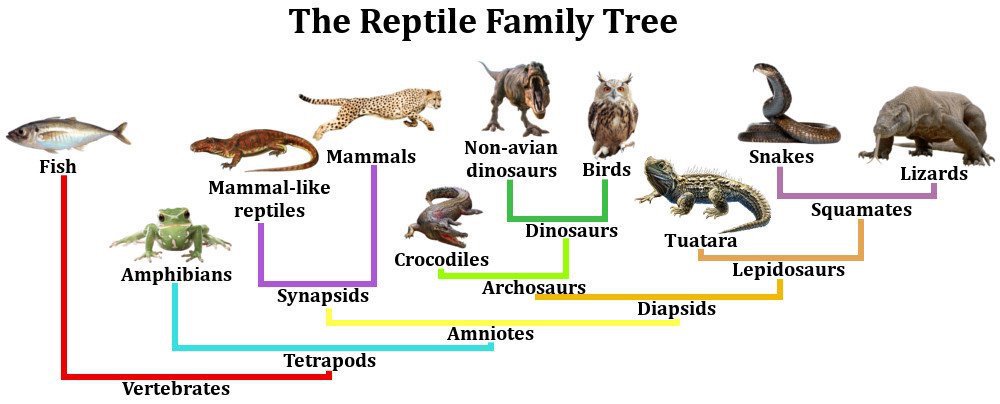Reptiles: Evolution and Ecology Study Guide
Introduction
There are around 10,000 distinct species of reptiles on the planet, and they are cold-blooded creatures from the Animal Kingdom of Phylum Chordata.
- Reptiles can be found in various places, like a desert, jungle, forest, or even our backyard.
- Their skin is covered with scales or bone plates. Turtles, crocodilians, squamates (lizards and snakes), and rhynchocephalia are examples of living reptiles.
- The first known proto-reptiles evolved from primitive Reptiliomorpha Tetrapods that were progressively suited to living on the dry ground some 312 million years ago during the Carboniferous epoch.
- In addition to existing reptiles, numerous different groups are now extinct, in some cases as a result of catastrophic cataclysms.
Reptile Classification
-
The members of the Reptilia class of air-breathing creatures with internal fertilization, amniotic gestation, and epidermal scales covering part or the whole of their bodies are called reptiles.
-
Amongst the major living reptiles are the turtles, tuatara, lizards, snakes, and crocodiles.
-
Extinct reptiles featured an even more diversified array of species, ranging from marine plesiosaurs, pliosaurs, and ichthyosaurs to enormous terrestrial plant-eating and meat-eating dinosaurs.
The following are some of the essential traits of creatures in the Reptilia Class.
- Reptiles are terrestrial creatures that crawl and burrow and have scales on their bodies.
- They are cold-blooded and live in most of the world’s warmer climates.
- Their skin is rough and dry, with no glands.
- The body is separated into four sections: the head, neck, trunk, and tail.
- Few of them lose their skin scales as skin casts.
- The use of the lungs accomplishes respiration.
- The skull has a single condyle.
- They have two pairs of pentadactyl limbs with claws on each. Snakes, though, are an exception.
- The heart has three chambers. Crocodiles, on the other hand, have a four-chambered heart.
- Reptiles lack the lateral line system.
- Except for snakes, all reptiles have well-developed ears.
- They have a standard cloaca.
- Reptiles are classified as ureotelic, uricotelic, or ammonotelic.
- Internal fertilization occurs in reptiles. The eggs are segmented in a meroblastic manner and are oviparous, with extremely yolky eggs.
Evolution of Reptiles
- Reptiles appeared some 300 million years ago, during the Carboniferous epoch.
- Casineria, one of the first known amniotes, possessed both amphibian and reptile features.
- Hylonomus was one of the first confirmed reptiles.
- During the Permian epoch, shortly after the first amniotes emerged, they split into three groups (synapsids, anapsids, and diapsids).
- The Permian epoch also saw a second significant separation of diapsid reptiles into archosaurs (crocodiles and dinosaurs’ ancestors) and lepidosaurs (predecessors of snakes and lizards).
- Due to the disappearance of huge anapsids and synapsids during the Permian-Triassic extinction, these groups remained unobtrusive until the Triassic epoch, when archosaurs became the dominating terrestrial group.
- The Mesozoic Era, also known as the “Age of Reptiles,” was dominated by dinosaurs, the ancestors of reptiles. Dinosaur domination persisted until the Cretaceous epoch, which marked the end of the Mesozoic Era.
Ecology of Reptiles
-
Reptiles are mostly found in temperate and tropical climates, with the highest number of reptile species found between 30° N and 30° S latitude. Nonetheless, populations of at least two species, the European viper and the common, or viviparous, lizard, also known as Zootoca vivipara, extend beyond the Arctic Circle (66°33′39′′ N latitude).
-
Other snakes, lizards, and turtles exist in high latitudes and elevations and have evolved habits that allow them to survive and breed with just three months of activity each year.
-
Reptiles may be found in almost any environment, from the open sea to the middle elevations of mountainous ecosystems. The yellow-bellied sea snake spends its entire life in the water, and it feeds and gives birth far from any shoreline and is helpless if swept ashore, unlike other sea snakes that reside in estuaries and coral reefs’ coastal waters. Sea turtles are mostly coastal creatures; however, most species undergo a migratory, or open-ocean, phase that lasts from hatchling to early adolescence.
-
Many snakes, crocodiles, and lizards are aquatic and exist in various freshwater settings, from vast rivers and lakes to tiny mountain streams. Turtles, snakes, and lizards can be found in woods, grasslands, and even genuine deserts. Lizards and snakes are the most common small-animal carnivores in many dry regions.
-
Reptiles can be found in diverse habitats. Except for Antarctica, they can be found on every continent. Most turtles live in the sea, whereas others prefer wetlands or ground. Lizards are all terrestrial animals, although their environments may range from deserts to rainforests and subterranean burrows to treetops.
-
The majority of snakes are terrestrial and exist in various settings, although some are aquatic. Crocodilians are found in and near wetlands, bodies of freshwater, and saltwater.
Conclusion
- The reptile groups exhibit a wide range of morphologies.
- Some species, such as most lizards and all crocodiles, have highly developed limbs, but others, such as worm lizards and snakes, have not.
- The flexibility of reptilian bodies ranges from the very flexible forms found in snakes to the stiff armored bodies found in turtles.
- Unlike mammals, birds, and some extinct reptiles, living reptiles have scales or scutes (rather than hair or feathers) and are cold-blooded.
- Except for Antarctica, modern reptiles can be found on every continent.
FAQs:
1. What is the evolutionary importance of reptiles?
Reptiles play a significant role in most ecosystems’ food webs. They play an important function as both predator and prey species. Herbivorous species can be key seed dispersers, especially on islands.
2. What are ways reptiles help the ecosystem?
Reptiles control overcrowding as predators, especially while they are young, as part of the larger food chain. Reptiles are also helpful in Insect and Rodent Control, Fish Control, Carrion Control, and Human food source.
3. What is the origin of reptiles?
Reptiles initially appeared around 310–320 million years ago, in the steamy swamps of the late Carboniferous era, when sophisticated reptiliomorpha developed into reptiles. Casineria is the oldest known animal that might have been an amniote.
4. What evolved from early reptiles?
Turtles, crocodilians, snakes, amphisbaenians, lizards, tuatara, and their extinct cousins are all members of this class.
5. What is the evolution of lizards?
Till now, morphological evidence suggested that iguanians (such as chameleons and iguanas) were the earliest contemporary lineage of lizards to emerge. However, molecular evidence suggested that geckos and dibamidae (a tiny family of limbless lizards) were the first to evolve.
6. How did reptiles evolve into mammals?
Mammals descended from a group of reptiles known as synapsids. These reptiles appeared during the Pennsylvanian Period (310 to 275 million years ago). By the middle of the Permian Period, a branch of synapsids known as therapsids had evolved (275 to 225 million years ago).
8. What era did reptiles evolve?
Reptiles first appeared some 300 million years ago, during the Carboniferous epoch.
We hope you enjoyed studying this lesson and learned something cool about the Reptiles: Evolution and Ecology! Join our Discord community to get any questions you may have answered and to engage with other students just like you! Don’t forget to download our App and check out our awesome VR classrooms- we promise, it makes studying much more fun!😎
Sources:
- Reptile Ecology. https://flexbooks.ck12.org/cbook/ck-12-biology-flexbook-2.0/section/12.18/primary/lesson/reptile-ecology-bio/ Accessed 4 Dec, 2021.
- Reptile Evolution. https://bio.libretexts.org/Bookshelves/Introductory_and_General_Biology/Book%3A_Introductory_Biology_(CK-12)/12%3A_Vertebrates/12.19%3A_Reptile_Evolution Accessed 4 Dec, 2021.
- Evolution and paleontology. https://www.britannica.com/animal/reptile/Evolution-and-paleontology Accessed 4 Dec, 2021.


